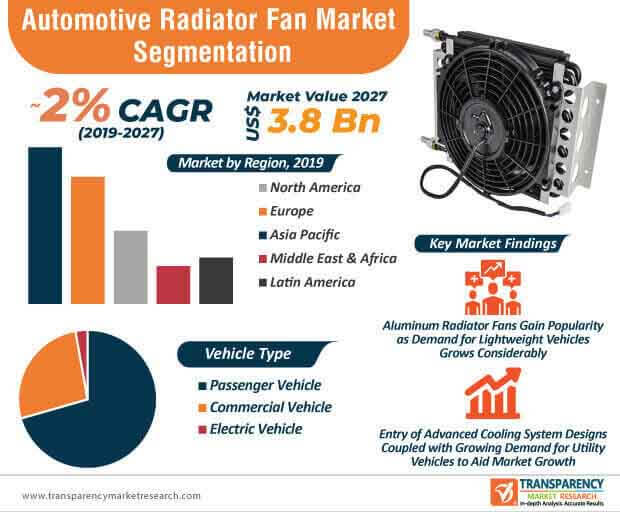
Soaring Demand for Lightweight Automotive Vehicles to Increase Adoption of Aluminum/Steel Radiator Fans
The automotive sector has experienced waves of innovations and new advancements over the past few decades. The emergence of modern technologies, the evolving regulatory landscape, and the growing demand for fuel-efficient automotive vehicles have played a key role in driving innovations in the automotive sector. In the current scenario, as automotive companies continue to focus on improving the performance and overall efficiency of their vehicles, a significant amount of resources are being invested to improve the functionalities of various automotive components. Over the past decade, automotive radiator fans have gained considerable spotlight, as they are expected to play a key role in enhancing the overall performance of the vehicle.
An automotive radiator fan is primarily used to regulate the airflow through the radiator, particularly when the vehicle is cruising at a very low speed. Automotive radiator fans are increasingly being used to regulate the temperature of the engine. The advent of cutting-edge cooling system designs, the high demand for utility vehicles in the Asia Pacific region, and fast-paced cooling system innovations are some of the key factors that are likely to drive the expansion of the global automotive radiator fan market. As the automotive sector continues to drift toward the development of electric and hybrid vehicles, participants in the current market landscape are expected to launch solutions that are in tune with the requirements of these vehicles.
Several automotive companies are emphasizing on the design aspects of the heat rejection strategies in electric motors due to which, innovations in automotive radiator fans are likely to shift gears during the forecast period. Several market players are expected to introduce innovative design concepts to strengthen their foothold in the market. At the back of these factors, the global automotive radiator fan market is expected to reach a value of ~US$ 1 Bn by the end of 2030.

Request a sample to get extensive insights into the Automotive Radiator Fan Market
Aluminum Radiator Fans Gain Considerable Traction, Adoption of Composite Variants Likely to Plateau
Over the past decade, due to growing environmental concerns, automotive players have increasingly emphasized using automotive components made from lightweight materials, including aluminum and steel. Similar trends can be observed across the global automotive radiator fan market, as market participants are increasingly focusing on producing automotive radiator fans made from aluminum and steel. Although radiator fans made from composite materials were largely popular in the past few decades, the demand for aluminum automotive radiator fans has witnessed impressive growth.
In addition, the recent oil crisis is another factor that has played a key role in urging automotive companies to manufacture automotive vehicles made from lighter materials. Aluminum radiator fans have gained considerable traction over the past few years, owing to its exceptional ability to withstand high temperatures. In addition, speculation in the market indicating a decline in the consumption of brass/copper radiator fans accelerated the production of aluminum automotive radiators. Although aluminum automotive radiator fans are growing in popularity across the world, radiator fans made from composite materials are expected to have a substantial market share, owing to the advent of new technologies, including laser welding, electrophoretic coating, and no lead brazing. Automotive players are likely to dillydally between aluminum and composite radiator fans during the forecast period.
To understand how our report can bring difference to your business strategy, Ask for a brochure
The Asia Pacific region is expected to dominate the automotive radiator fan market in terms of share and value due to the flourishing automotive sector in China and India. Automotive manufacturers in these regions are increasingly focusing on optimizing the performance of their vehicles due to stringent government guidelines and mounting environmental concerns.
Disruptions in Supply Chain amid COVID-19 Pandemic to Negatively Impact Market Growth
The onset of the novel COVID-19 pandemic has clipped the wings of the global automotive sector due to which, the automotive radiator fan market is expected to witness sluggish growth in 2020. Due to disruptions in the supply chain caused by the COVID-19 pandemic, automotive radiator fan exports are likely to witness a decline in the second and the third quarter of 2020. While exports from China took a massive hit in the first quarter of 2020 due to lockdown and containment measures, industries have gradually opened up due to which, the production of automotive radiator fans has resumed.
In addition, the slowdown in the demand for automotive has led to a considerable decline in commodity prices. However, the large-scale plant closures by the OEMs in Europe and North America are likely to affect the prospects of the global automotive radiator fan market amid the COVID-19 crisis. Several automotive companies are eyeing diversification across the supply-chain in the post-COVID-19 era. For instance, several companies in India, including Tata Motors and Maruti are likely to lead toward sourcing automotive components from domestic companies.
Stuck in a neck-to-neck competition with other brands? Request a custom report on Automotive Radiator Fan Market
Automotive Radiator Fan Market: Overview
- The global automotive radiator fan market is anticipated to expand at a CAGR of ~2% during the forecast period, owing to the rise in sale and production of vehicles across the globe that has led to an increase in consumption and hence, is expected to boost the production of radiator fan. Increase in demand for electronic systems in vehicles, including electronic control unit and infotainment system; high penetration of air conditioning systems; and a surge in the demand for fuel-efficiency are likely to propel the global automotive radiator fan market during the forecast period.
- Demand for radiator fan in vehicles is increasing due to an increase in trend of downsized engine and rise in demand for electric vehicles, as large air flow is required to reduce the heat generated through the engine and electric power consumption in electric vehicles. This is projected to boost the automotive radiator fan market across the globe.
Drivers of Automotive Radiator Fan Market
- Rising urbanization and demand for smart cities around the world has propelled the usage of passenger cars and light commercial vehicles significantly, which is likely to augment the automotive radiator fan market during the forecast period
- Vehicle manufacturers, especially engine manufacturers, are anticipated to invest heavily in research & development to design and develop new and technologically advanced engine components. This is projected to boost the automotive radiator fan market during the forecast period.
- In equatorial, hot, and humid regions, including countries in the Middle East, Brazil, India, Indonesia, countries in Africa, Colombia, and other humid regions, integration of an air condition in the vehicle has become a necessity. Continuous air flow is required to maintain consistent cooling of the vehicle. This is performed by the automotive radiator fan, which maintains temperature of the engine and increases air conditioning performance via constant airflow across the condenser. This is projected to boost the automotive radiator fan market across the globe.
Challenges for Automotive Radiator Fan Market
- The COVID-19 pandemic has fueled medical concerns and health awareness, which is estimated to boost the demand for intelligent air purification systems or UV sterilization systems in passenger vehicles. This, in turn, is projected to restrain the global automotive radiator fan market. Major vehicle manufacturers are focused on the development of anti-bacterial and anti-microbial air conditioning systems, which is also estimated to hamper the global automotive radiator fan market.
- Automotive radiator fans consume higher power, react to antifreeze chemicals and vibrations, which limits the application of flex and clutch fans in a few vehicles. This, in turn, is anticipated to hamper the automotive radiator fan market. The radiator fan has a short lifespan and requires periodic replacement, which is likely to increase the maintenance cost of the radiator fan.
Segmentation of Automotive Radiator Fan Market
- Based on vehicle type, the passenger vehicle segment dominated the global automotive radiator fan market due to a rise in production of passenger vehicles across the globe. Rise in penetration of advance cooling system in passenger vehicle is estimated to further boost the automotive radiator market across the globe.
- Based on radiator fan type, the electric radiator fan segment dominated the market, as demand for electric vehicles has been rising in across the globe due to enactment of stringent rules and regulations regarding vehicle emission
Automotive Radiator Fan Market: Regional Analysis
- Based on region, the global automotive radiator fan market has been segregated into North America, Asia Pacific, Europe, Latin America, and Middle East & Africa
- Asia Pacific and North America are projected to be highly lucrative markets during the forecast period. This is primarily owing to the presence of prominent automotive industry in the U.S., China, Japan, and India. Consistent rise in vehicle production across the Asia Pacific and North America region is anticipated to drive the automotive radiator fan market during the forecast period.
Automotive Radiator Fan Market: Competition Landscape
- Key players operating in the global automotive radiator fan market include
- AMETEK Inc.
- Denso Corporation
- Valeo SA
- FLEXXAIRE
- BorgWarner Inc.
- CalsonicKansei North America Inc..
- Delta Radiator Fan Ltd.
- ebm-papst
- Guangzhou Tech Master Auto Parts Co., Ltd
- Horton Holdings Inc.
- Multi-Wing International a/s.
- SPAL Automotive
- Sunonwealth Electric Machine Industry Co. Ltd
- Toshiba Electronic Devices & Storage Corporation USUI Co. Ltd
- YILI Technologies
- Bergstrom Climate Control Systems
- AVID Technology Limited
- Key players at the global level are expanding their footprint by engaging in mergers and acquisitions with several players in industry. In 2018, Horton Holding, Inc. introduced a range of fans and drivers at the IAA 2018 event in Hanover, Germany. The newly introduced fans and drivers are especially made for on-highway vehicles. The company’s drivers are capable of providing excellent control, especially at low speeds, reduced power consumption, and lower noise. In 2018, BorgWarner Inc. introduced several new technologies at Auto Expo India for efficient and clean propulsion of vehicles. The new technologies included e-Booster, which is an electrically driven compressor and 48 volt electric fan. In 2016, Sunonwealth Electric Machine Industry Co., Ltd. introduced new products, the high flow DC ventilation fan and high efficiency VF fan series, for the automotive industry.
Read Our Latest Press Release:
About Us
Transparency Market Research is a next-generation market intelligence provider, offering fact-based solutions to business leaders, consultants, and strategy professionals.
Our reports are single-point solutions for businesses to grow, evolve, and mature. Our real-time data collection methods along with ability to track more than one million high growth niche products are aligned with your aims. The detailed and proprietary statistical models used by our analysts offer insights for making right decision in the shortest span of time. For organizations that require specific but comprehensive information we offer customized solutions through ad-hoc reports. These requests are delivered with the perfect combination of right sense of fact-oriented problem solving methodologies and leveraging existing data repositories.
Contact
Transparency Market Research State Tower,
90 State Street,
Suite 700,
Albany NY – 12207
United States
USA – Canada Toll Free: 866-552-3453





